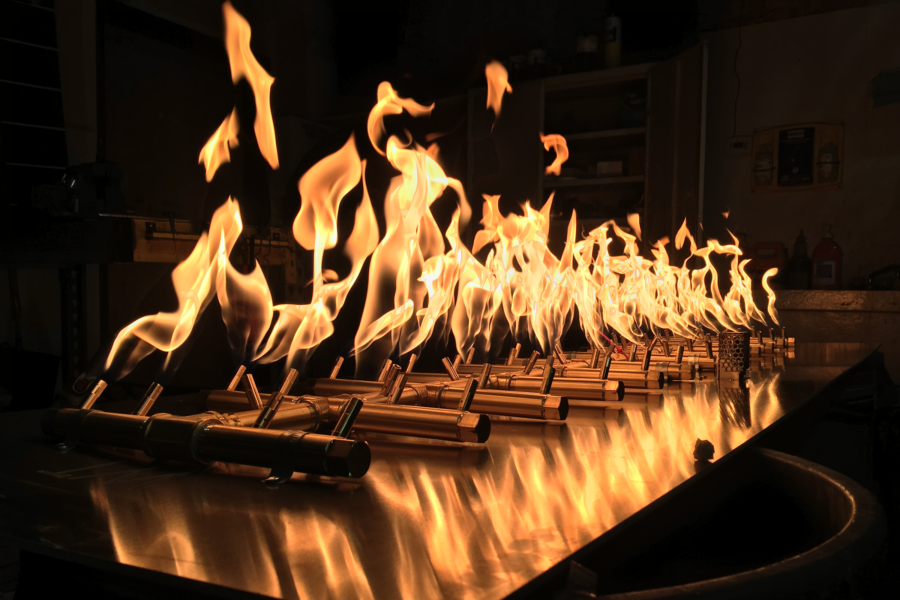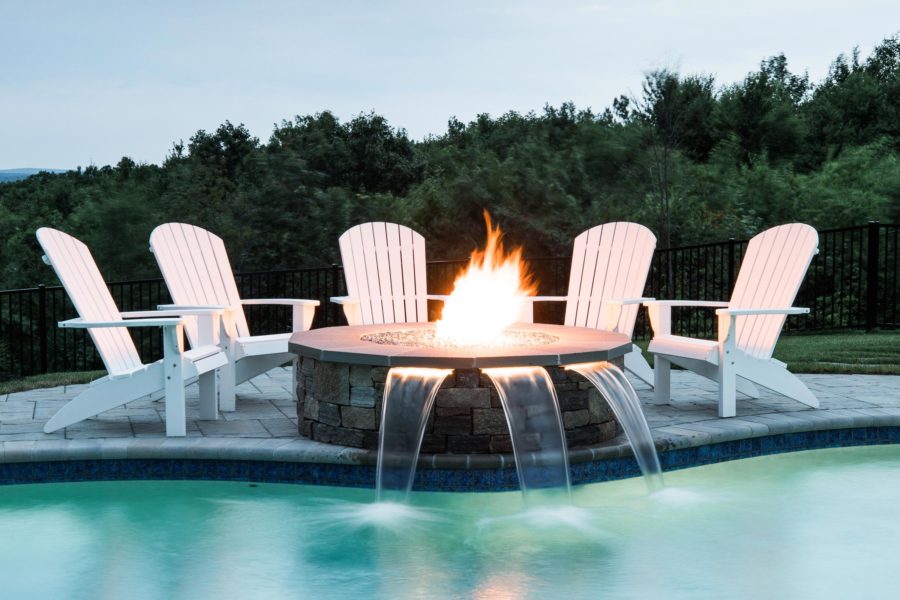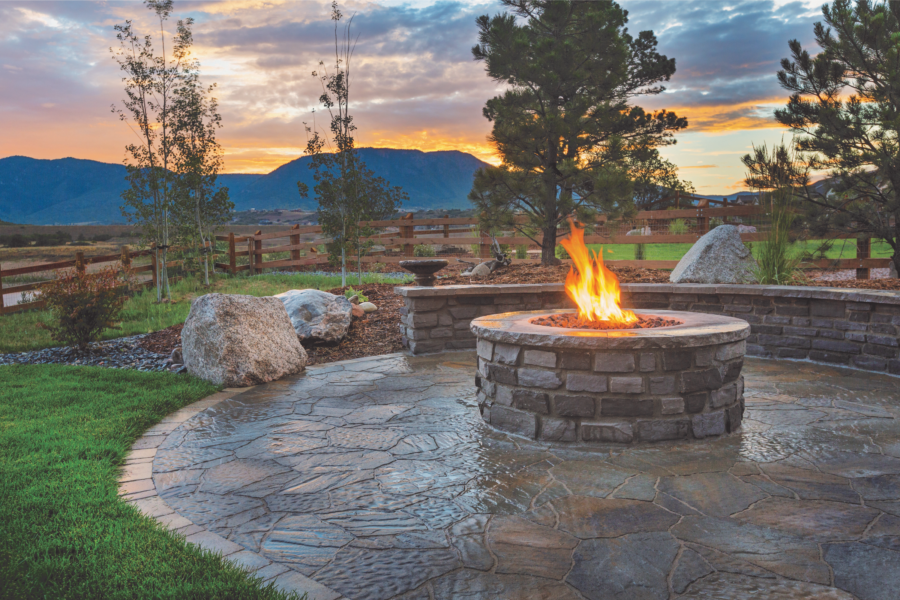Fire features are the focal points of outdoor living spaces and can be the deciding factor between your client saying, “Wow!” and “Meh” when the project is unveiled. I have had the pleasure of working on hundreds of projects with architects, design build firms, and many different retailers throughout North America, and with every project I always come out learning something new.
Here are a few insights that I have found valuable to ensuring that the space you create with an outdoor fire feature lives up to expectations.
Benefits of Gas Fire Features

Photo courtesy of Warming Trends
When designing an outdoor living space, whether you already have a vision in place or you are working through the discovery process with your client, you will always want to consider adding a fire feature. The benefits of fire can be significant, and customers always enjoy having an area of their outdoor space that creates a place of peace, enjoyment, or maybe just warms them up.
Gas fire features create an added level of convenience when compared to wood-burning units. The fact that they can be lit with ease and cleanup is almost nonexistent (outside of picking up some wine glasses or beer bottles from sitting around the fire), is usually all that needs to be mentioned to convince a client to use a gas feature. When it comes to sustainability, the benefits of gas features versus wood are significant, as natural gas and propane are clean-burning and smoke-free.
Fire Feature Design Flexibility

More designers are including fire and water in their landscapes, whether as a focal point or accent. Photo courtesy of Dragonfly Ponds and Patios
Once your client has decided to incorporate a gas feature into their project, you will need to consider the various styles of features available. From GFRC to metal, fireplace versus pit, and natural stone to veneer, there are many design options available. You will want to ensure your client has reviewed their options and has selected a pit that aligns with their personal preference.
For example, does the client want a traditional fire pit with ceramic logs and large flames? Or maybe they prefer a more artistic approach to the pit with fire glass or steel logs? Asking these kinds of questions to understand the design style is always helpful in ensuring that you understand what your client is envisioning.

Photo courtesy of Warming Trends
If the project has a lot of curvature and rounded shapes to it, naturally you may offer a feature that is either circular or radial. If the project has sharp corners and angles, a square or rectangular feature is usually the right option. If you are looking to create an abstract feature, there are a select few manufacturer’s that can provide custom inserts. These companies will usually request a preliminary design—I always say if you can draw it on a napkin, we can design it—to provide introductory options.
How Location Plays a Role
Understanding what type of environment your client lives in will help you understand additional factors that should be considered in the design phase. Ask questions such as how cold does it get at night in this area? Will the feature be used as a source for heat or ambiance? If I know that the project is in a northern area, it is a safe assumption that the client is looking to use the fire feature to provide heat. If that is the case, I will always ensure that we discuss gas supply and how that impacts the heat output of the system.
How Gas Lines Impact Fire Features’ Performance
Gas lines are the life support to your gas feature. Once you have established a design for your feature, you will want to review the BTU rating of the burner via the manufacturer’s specifications. Different companies can produce different BTU outputs based on the design of their burner systems, so make sure that you do not attempt to use a “one-size-fits-all” approach.
Understanding gas pipe size charts is useful when sizing gas lines, but you will want to consult with the plumber running the gas line to ensure that your pressures match. If your plumber ever says, “That isn’t right, we have a higher pressure and can run a smaller line”—trust them.
Making Clients Comfortable with Gas Fire Features

Photo courtesy of Warming Trends
I have found that many companies Warming Trends interacts with usually have some concern when it comes to gas features. This is understandable, but I can reassure them that the features are safe by discussing the following items:
Ventilation
The national code for gas fire pits requires 18 square inches of ventilation on opposing sides of the fire feature. This ensures that the feature will not be able to pool gas in the cavity of the pit and create a potential explosion.
Lighting Process
There are various ignition types for fire features, including: match light, push button, 3-volt ignition, or 24-volt ignition. When operating a match light or push-button ignition, it is important to remember that you need to open the manual valve—commonly in the form of a key or knob—slightly, light the burner (the flame should be low at this point), and then open the valve completely. This process ensures that there is not a “poof” of flame that can potentially singe a customer’s hair.
When using an ignition system, the customer is using a switch, remote, or another on/off point. This keeps the customer further from the feature, so lighting the system slowly is not much of a concern in this application.
Fire-Rated Media
There are many different fill options for fire features, but it is important to ensure that you are using fire-rated material. If the material is not fire-rated, it can explode when the fire pit is in use due to the pockets of water that can be captured in this material. Even when operating a feature that has fire-rated media, I would never recommend lighting it when the media is wet.
I have always felt that fire features are one of the best ways to create a space in today’s world where people can socialize. One of my favorite parts of my role in this industry in talking through the experiences that happen around the fire. I have heard stories that warm the heart and stories that can make you laugh uncontrollably. The fact that I have had the opportunity to create spaces like this for people all around North America has been a true pleasure and I look forward to hearing more stories in the future. If there is anything that I hope you can leave with, it is how to create the ideal space for your client so they may experience the next memory that will last a lifetime.




